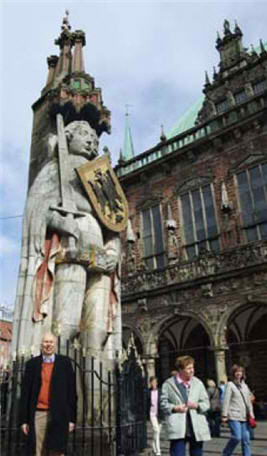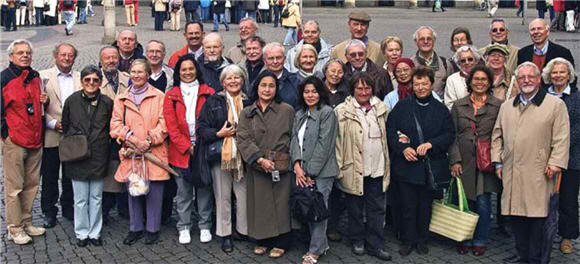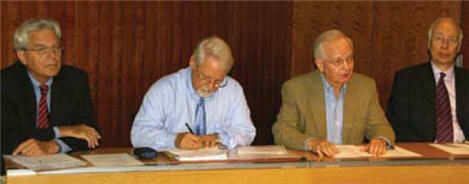The 12th chapter meeting was held in Bremen on 4–7 September. The excellent tour hosts were Roland and Clarissa Engelbart.
Bremen. Bremen is an old settlement in NorthernGermany. Full market privilege was conferred on thetown in 965 AD, and in 1358 it joined the HanseaticLeague, an association of merchant cities in NorthernEurope. For much of its history, Bremen was a cityrepublic governed by merchants.

Roland Engelbart at the Statue of Roland.
Today, Bremen (with 560,000 inhabitants) andits sister city Bremerhaven (with 120,000) make upthe smallest German federal state. Located 60 kmfrom the North Sea on the Weser River, Bremen isGermany’s second largest port after Hamburg. It is alsoan important industrial center (Mercedes production,Ariane rocket and engine components, Airbus parts).Shipyard activity has almost vanished, however;containerization and the use of larger ships have seenport activities move downstream to Bremerhaven.
The Reunion. On Friday participants arrived fromAustria, France, Germany, Luxembourg, Netherlands,Switzerland, the UK, and even Thailand and thePhilippines. Most stayed in the Swissôtel, in the citycenter.
The reunion started with a buffet dinner at theRatskeller underneath the City Hall, built in the 17thcentury. Patrons sit at long oak tables surrounded byhuge wine barrels built into the walls. The Ratskellerserves only German wine. It has a stock of morethan 600 wines including one dating to 1730 butsupposedly still drinkable. Among many prominentvisitors have been Heinrich Heine and Friedrich Engels.

In front of Bremen’s Chamber of Commerce: Hans-Juergen Springer, Jan Wijenberg, Hertha Escher, Thomas Eggenberger, Hans-Martin Schmid, Lilo Kahl, Hermann Escher, Rose de Vries-Bal, Siward de Vries, Gerhard Kahl, Monique Freiwald, Lek Lepper, Peter Bodora, Dieter Bodora, Günther Schulz, Enrie Hecker, Helga Schulz-Berlin, Ulf Freiwald, Gisela Carstensen, Gertrud Koehling, Paul Koehling, Peter von Brevern, Friedrike Kantner, Elizabeth Reyes, Marlis von Brevern, Clarissa Engelbart, Gudrun Varwig, Enno Carstensen, Eva van der Elst, Günter Hecker, Aafje Schmid, Eric van der Elst, Marianne Wijenberg, and Roland Engelbart.
A Walk through History. The Saturday programstarted with a walk through the historic center,beginning at the Market Square, often called the “neatliving room” by Bremeners. The square is dominated bythe 600-year-old City Hall, which displays a beautifulRenaissance façade, rich ornamentation, fine statues,and a copper roof. Tourists always gather rounda modern sculpture known as the Bremen TownMusicians.
A statue of Roland, erected in 1404, is in frontof the City Hall. The figure has a youthful faceand a secretive smile. With a drawn and uprightsword, Roland faces the cathedral as a symbol of independence of the Bremen citizens against thearchbishop’s claim to supremacy over the city.
Opposite the City Hall is the Schütting, traditionallythe seat of the merchants and today the Chamberof Commerce. The doorway shows the motto of theBremen merchants: “Buten und binnen, wagen undwinnen” which, in low German, means outside andinside, venture and win.

Europe chapter's business meeting (L–R): Hans-Juergen Springer, Günter Hecker, Günther Schulz, and Roland Engelbart.
The group next visited St. Peter’s Cathedral, designed in Gothic style with 98-meter high twin towers. Passing by the Schütting, a small alleyway led the group to the Böttcherstrasse, originally a small street where barrel makers lived. Around 1900, Ludwig Roselius, a coffee maker and benefactor of the arts, bought all the houses and converted them into a delightful street museum. The expressionist landscape of façades executed with colored glass, steel, and bricks reflects well the spirit of Jugendstilt, the thenpopular Arts and Crafts Movement.
The next stop, along the Weser riverbank, was Bremen’s oldest quarter, the Schnoor. The name derives from the word for string. Indeed, the small houses along the narrow streets really do look like pearls on a string. The Schnoor has become Bremen’s most popular tourist attraction, but it has not degenerated into being solely a museum. The old houses with their artists’ studios, art galleries, cafés, restaurants, and cosy taverns create a pretty and peaceful atmosphere.
Discoveryand Revelry.After a breakfor an Italianlunch—inevitablya big pizza—acoach took thegroup on a 2-hour guidedtour throughparts of Bremen,including theuniversityarea and thetechnologypark. TheFocke Museum,dedicated toBremen’s history,was anotherbrief port of call.All in all, thegroup realizedthat airiness andspaciousness arecharacteristicsof the city, as Bremen possesses many parks andopen spaces and close links to the surroundingcountryside.
Saturday evening was dedicated to the traditionalEurope Chapter Gala Dinner in the Swissôtel ballroom.Before the dinner, participants commemorated thepassing away of Ikramullah Khan with a moment ofsilence.
Short speeches between courses were delivered. Roland, the host, summarized the traditional festivities unique to Bremen. The Schaffermahlzeit, the most important, is a banquet with prominent guests coming from commerce, industry, culture, and politics. It is arranged every February by a charitable foundation for Bremen's seafarers and is celebrated in the Upper Hall of the City Hall. The banquet is considered to be the oldest fraternity meal in the world, first held in 1545.
On Sunday morning, the program continued with an excursion by train to Bremerhaven. A double-decker bus took the group on a 2-hour guided tour through the port area. Container traffic, transport of heavy-duty equipment, and the shipment of cars are the pillars of Bremerhaven's harbor business. The container quay is 5 km long, and there is parking for 80,000 cars. Bremerhaven is Europe’s largest port for the import and export of new cars for Europe, the US, and East and Southeast Asia.
However, as the tour guide explained, in 2009, after a long period of success, the clearance of container freight ships was down about 20%, and car cargo by even more. He also pointed out the “condomiums for bachelors.” (We later found out he meant the row of modern condominiums along the Port perimeter.)
Next was the German Emigration House, where more than 7 million migrants from Germany and East Europe gathered to sail for the New World. The museum provides a lively impression of how the emigrants must have felt—the farewell in Bremerhaven, accommodation on board, arrival at Ellis Island, the receiving station in front of Manhattan Island. The Gallery explains the emigration and has biographies of emigrants. It also offers a database for family research on passengers.
Dinner was taken the Jürgenshof, afarmhouse-type restaurant with German cuisine,near the meadows of the Weser.
Business Meeting and Farewells. On Monday morning, the AFE–ADB Business Meeting was held. (The minutes have been circulated.) Participants at the gala dinner had suggested that Mehbooba Khan be accorded honorary membership in the Europe Chapter. This was confirmed. (She subsequently accepted.). Peter Bodora, known for his forceful and imaginative planning, gracefully volunteered to organize next year’s reunion in Dresden. When reminded that we had grown 7 years older since his splendidly organized Lübbenau Reunion, covering wandering in open-pit coalmines, discussions on privatization with the electricity company Vattenfall, and a boat trip through the Spreewald (the Sundarbans of Germany), the need to also recruit new retirees was recognized.
After the reunion, Roland and Clarissa invited those remaining in Bremen to their old Bremen town house. Sitting in the living room or on the balcony with a cup of coffee or tea and German cake at hand, everybody felt relaxed, happy, and thankful that AFE provides opportunities for reunions. See you in Dresden!
